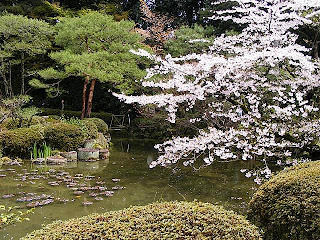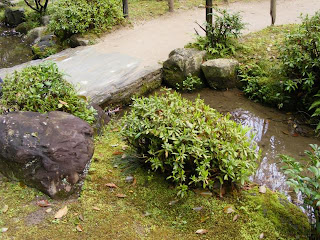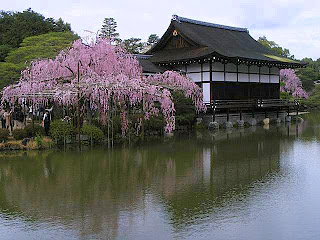Shinto comes from the Chinese “shin tao”, meaning “the way of kami”. Kami are the ancient deities or spirits, to whom the Japanese prayed long before the introduction of Buddhism in Japan (VI-th. century). Shintoism has no foundation data, nor a founder, being as old as the Japanese people, and sustaining the divine origin of the emperor. It is based on the old agricultural rituals and shamanism, and the principles of the Chinese Confucianism and Taoism (arrived in Japan on the 5-th century), with the two basic natural forces, yin and yang, being in harmony. When the political power begun to be centralised, Shintoism became a national cult. Practicing, means purification, prayers and offerings to the kami. Surely, this is a very loose explanation, just to point to some important ideas for those who do not know much about Shintoism. Those interested, could find a lot of information on internet.
Heian Jingu was constructed in 1895, when Kyoto celebrated the 1100-th. anniversary of its founding by the Emperor Kammu. It is a 2/3 replica of the old Imperial Palace, burned in 1127. In front of the altar, a huge tori (gate specific to shinto altars), the biggest in Japan, has a 24.2 m height. The characteristic colors of the altar are bright orange, white and green. The constructions are two main halls and the great hall of the throne, were the emperor issued his decrees. This part could be visited free of cost.
To see the splendin Shin’en garden, you have to pay 600 yen. The entrance is on the left of the great hall of the throne.
The garden is splendid in the spring, when the weeping cherry trees are blooming. Their intense pink colored petals determine a lot of “wow”s from the visitors. It is a garden built on 1912 by Ogawa Jihei, the pioneer of the modern Japanese garden.
Here, as in Chiang Mai, Thailand (if you remember), I was approached by two sutdents, who asked me if I am willing to let them accompany me in the courtyard and explain me about Heian Jingu. I did my lessons home, but I was really glad to speak with them. In the end a photo was produced as proof that the discussion took place:)
Pentru ca locuiam la doar 10-15 minute de mers pe jos, am ales sa vad prima data Heian Jingu, altar shinto imperial.
Inainte de a va arata insa altarul, trebuie sa va spun ca in Japonia principalele religii sunt budhismul si sintoismul. Sinto, care nu este propriu-zis o religie, are ca etimologie chinezescul shin tao, adica “calea kamiilor”, kami fiind diversele zeitati antice/spirite carora li se inchinau japonezii cu mult inainte de introducerea budhismului (secolul VI e.n.). Nu se cunoaste nici data, nici vreun intemeietor al sintoismului. El este tot atat de vechi ca si poporul japonez. Vechile ritualuri agricole si samanismul stau la baza sa. Peste acestea s-au asezat principii ale filosofiei confucianiste (sosita in Japonia in secolul V e.n.) si taoiste, cu principiile sale de yin si yang, cele doua forte de baza ale naturii, care trebuie sa fie in armonie. Odata cu centralizarea puterii politice, sintoismul s-a dezvoltat intr-un cult national, strans legat de originea divina a imparatului.
Intrucat practicarea sintoismului se traduce prin ofrande aduse kamiilor la un altar (alaturi de purificare si rugaciuni) , in secolul al X-lea existau deja in Japonia peste 3000 de altare. In timp, au aparut diverse grupari sintoiste dar, dupa cel de-al doilea razboi mondial, statutul de religie oficiala a disparut. Desigur, acestea sunt doar cateva idei, discutia despre sintoism putand fi foarte lunga si neavandu-si locul aici decat pentru a putea intelege mai bine de ce voi vorbi mereu despre temple budhiste si altare sintoiste.
Asadar, in anul 1895, sarbatorindu-se 1100 de ani de la fondarea capitalei Heian (Kyoto) de catre imparatul Kammu, a fost construit altarul Heian Jingu care reprezinta a replica in marime de 2/3 a vechiului Palat Imperial, distrus in 1227.
Deoarece orice altar sintoist are in fata o poarta, numita tori, gasim una si la Heian Jingu. Nu este insa una oarecare ci cel mai mare tori din Japonia, construit in 1929. El are o inaltime de 24.2 m, iar bara de sus masoara 33.9 m in lungime.
Caracteristice cladirii sunt culorile portocaliu aprins, alb si verde.
Shimenawa, franghia care deosebeste locurile sacre de celelalte si apare la toate altarele sintoiste
Sunt trei cladiri principale, dintre care una – marea sala de stat – este cea in care imparatul emitea decretele sale. In curtea altarului am fost abordata, ca si la Chiang Mai in Thailanda, daca va amintiti, e doi studenti care m-au intrebat daca accept sa ma insoteasca si sa-mi explice despre ce este vorba. Am acceptat, desi imi facusem deja lectiile, fiindca imi place sa stau de vorba cu tinerii. De fapt, a vorbit doar baiatul, explicandu-mi ca fata este in anul I si, deci, mai timida.
In curte se vand amulete purtatoare de noroc sau oamenii cumpara niste biletele, purtand dorintele lor, si le agata in pomi.
Toata aceasta zona se viziteaza gratuit, la nici un altar sinto neexistand taxa de intrare. Daca vrei insa sa vizitezi gradinile, pentru care Heian Jingu este vestit, trebuie sa platesti 600 yen.
Gradina Shin’en este cea care etaleaza acum splendoarea ciresilor plangatori, cu flori colorate roz intens. O multime de oameni ii fotografiaza sau doar ii admira. Aceasta gradina a fost construita in anul 1912 de catre pionierul gradinii japoneze moderne, Ogawa Jihei. Este vorba, de fapt, despre patru gradini, care inconjoara marea sala a tronului.
In gradini se afla mici lacuri care oglindesc coroanele contorsionate ale pinilor japonezi. Un tori sau lanterne de piatra, precum si Garyu-kio, pietre pe care se paseste pe apa, poduri sau simple punti de piatra sunt tot atatea caracteristici ale gradinii japoneze.
Pe malul unui lac o mica ceainarie imi prilejuieste un popas, alaturi, de alti vizitatori. Este locul in care mananc si o inghetata de ceai verde.
Aleea serpuieste pe langa mici piriuri pana ajunge la alt lac, traversat de un pod din lemn, acoperit, de inspiratie chineza.
S-ar putea sta ore intregi aici dar e abia dimineata si eu mai am multe de vazut astazi…Parca a inceput sa se si insenineze putin!








































Ce frumos e copacul ăla cu dorinţe!
Weeping cherry blossoms in Shinen Garden is beyond description,Traveling Hawk!
And I bow to your knowledge of Japanese Shinto.
Asa e Liliana! Am intalnit si in Cappadocia asa ceva dar astia sunt mai sobri, nu asa colorati.
Did you like my demonstration in Nara, Kumiko? I read on internet but I also learn from these two students!
Ei, da, serialul se continua !!! Minunat !!!
Multumesc, Dani!
What beautiful photos my favorite friend!!!
Japan is a very beautiful country!
The gardens, temples, all are charming!
I thank you for the tour interesting and valuable information!
Have a wonderful weekend!
Dear Magda, thank you for your nice words!
Such a lovely place… as if from a Murakami novel!
Hello, Traveling Hawk.
The work including spring.
The vitality of the heart is made to arise.
I am glad of your visit, though each other is far distantly.
The prayer for all peace and healthy.
Have a good weekend. From Japan, ruma ❃
Good Shinto lesson, and spectacular photographs.
Thank you, ruma! I am very glad that I have seen all these places.
Welcome, Click Click, on my blog! Do you like Murakami? Me too.
Thank you so much, Barbara/myth maker!
Heian Jingu looks splendid in spring, with those stunning cherry blossoms! We were there in the fall, and arrived too late to go into the garden. But it was impressive to see just the building. Lovely to see it through your camera. And nice to see you with the students! 🙂
Thanks, Francisca! May be some other time you can go to Japan on spring. I would like to see it in the late autumn.
Yeah,I liked it very much,Traveling Hawk.
I was astonished by your knowledge.
🙂
Nice day, that in Nara, Kumiko!
Again very interesting to read Traveling Hawk, and I’m glad you again had 2 students who would accompany you. Act I is not much a yen, only 600 yen to pay is a sort of gift I think.
Beautiful pictures.
Greetings, Helma
Thanks, Helma! About the costs, this is another discussion…Seeing more, it amounts to more money, so I had to save them before I went to Japan…